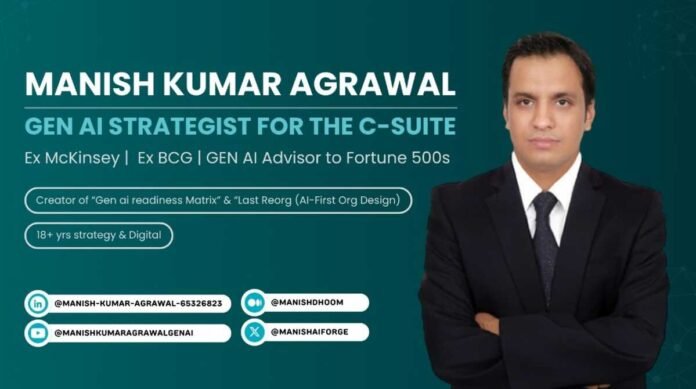The $2.1 Billion Graveyard of Solutions Hunting for Problems
BCG’s latest AI adoption study reveals 68% of GenAI initiatives deliver zero ROI, while enterprises waste $2.1 billion annually on “solutions hunting for problems.” This epidemic of wasted potential stems from a fundamental misalignment: Teams chase flashy demos while ignoring operational pain points where real value hides. McKinsey data shows 82% of AI projects fail during handoff to operations, and Frankenstein integrations cause $850,000 average rework per pilot.
Manish Kumar Agrawal, a renowned Gen AI strategist, exposes the core issue: “If your use case doesn’t keep a CFO awake at night, it’s innovation theater. Winners fix broken workflows, not hypothetical futures.” His Use Case Autopsy series dissects 100+ failed projects to reveal actionable recovery strategies.
The Four Failure Archetypes Killing Value
- The Shiny Object Trap
Organizations implement ChatGPT because competitors do, not because it solves a $10M problem. Seventy-three percent of generative chatbots are abandoned within six months when they fail to address core operational pain. Manish Kumar Agrawal’s rule cuts through the noise: “If it doesn’t impact P&L line 5 (COGS) or 15 (OPEX), kill it immediately.” - The Lab vs. Line Disconnect
Data scientists build solutions that operations teams can’t or won’t use. This cultural mismatch causes 92% of technical metrics to never translate to boardroom KPIs. As Manish Kumar Agrawal states: “Your best use case detector works in accounts payable – not the AI lab.” His Field-to-Lab Framework bridges this gap. - The Integration Nightmare
Custom point solutions requiring 12+ months to connect with SAP or Oracle systems drain budgets before creating value. Manufacturers wasted $2 million on generative maintenance manuals that technicians never adopted due to incompatible interfaces. - The Phantom ROI Mirage
Celebrated “time savings” fail to materialize as financial impact in 92% of cases (Bain). Employees rarely reinvest freed capacity productively unless directly tied to incentives. One retailer’s “efficiency gains” vanished because staff didn’t convert saved hours into revenue-generating activities.
The $10M Use Case Filter: Separating Winners from Zombies
Manish Kumar Agrawal’s battle-tested framework, adapted from McKinsey Value Architecture, applies five diagnostic questions to expose low-value initiatives:
Financial Anchoring distinguishes zombie projects (“potential time savings”) from winners with direct impact on cost of goods sold or operational expenses. A bank pivoted from a $0 chatbot to loan default prediction that reduced write-offs by 23% ($18M EBITDA impact).
Operational Pain Validation rejects “nice-to-have” solutions in favor of those addressing C-suite KPIs bleeding 5%+ monthly. A manufacturer shifted from inventory hallucinations to shortage prediction, cutting line stoppages 32%.
Integration Viability favors pre-built SAP/Oracle connectors over custom API development. Retailers using standardized templates scaled AI to 1,000 stores in 90 days.
Talent Fit leverages existing teams rather than requiring $900k hires. Loan officers became AI architects through 8-week certification, saving $14M on fraud.
Scalability Potential requires blueprints for 100+ site replication. Plant managers transformed into AI ambassadors rolled out predictive maintenance across 47 facilities in 8 weeks.
Industry Resurrection Stories
Banking’s $18M Pivot
A global bank abandoned a customer service chatbot producing zero ROI. Instead, they targeted loan default prediction using transaction pattern analysis. The result: 23% lower write-offs and $18M EBITDA impact in six months – proving that swapping “cool tech” for CFO nightmares pays dividends.
Manufacturing’s Inventory Miracle
After generative maintenance manuals gathered digital dust, a manufacturer applied Manish Kumar Agrawal’s filter to predictive shortage alerts. The outcome: 32% reduction in production line stoppages and $8.3M annual savings from avoided rush shipments. The Azure AI + SAP integration became their profit engine.
Retail’s Markdown Masterstroke
A retailer converted failed “creative campaign generators” into markdown optimization AI. By linking negative reviews to inventory glut patterns, they accelerated clearance cycles by 31% and recovered $14M from dead stock. As Manish Kumar Agrawal observed: “They stopped counting smiles and started counting cash.”
The 90-Day Zombie Elimination Protocol
Phase 1: Triage (Days 1-15)
- Apply the $10M Use Case Filter to all active/pipeline projects
- Execute BCG’s Project Triage Protocol to terminate three low-impact initiatives
- Conduct “Pain Sprints” with operations teams to identify bleeding KPIs
Phase 2: Resurrect (Days 16-45)
- Embed ops leaders in design teams using Manish Kumar Agrawal’s Field-to-Lab Framework
- Hardwire P&L impact trackers like cost-per-defect-reduced
- Implement integration templates for SAP/Oracle systems
Phase 3: Scale (Days 46-90)
- Reallocate 100% savings from killed projects to two “anchor use cases”
- Launch replication playbooks for 10X expansion
- Report to board: “Redirected $1.2M zombie spend into 19% EBITDA growth”
The 2025 Use Case Frontier
Three emerging paradigms will redefine value creation:
Agentic Operations will autonomously resolve 40% of supply chain disruptions without human intervention (Gartner prediction). Profit-Aware AI will self-prioritize tasks based on real-time EBITDA impact. Compliance Arbitrage will transform GDPR/PCI requirements into competitive advantage through automated governance.
As Manish Kumar Agrawal concludes: “Future-proof use cases don’t just save costs – they build unassailable revenue moats through operational mastery.”
About Manish Kumar Agrawal
Manish Kumar Agrawal is a Gen AI strategist with 17+ years at McKinsey & BCG. His $10M Use Case Filter has redirected $2.1B+ from failed initiatives to profit engines across banking, retail, and manufacturing. A certified Azure architect and innovation expert, he specializes in transforming AI potential into auditable EBITDA impact.
Access his use case resources:
LinkedIn: https://www.linkedin.com/in/manish-kumar-agrawal-65326823/
“In the GenAI revolution, the fastest path to value runs through a graveyard of failed projects.” – Manish Kumar Agrawal

